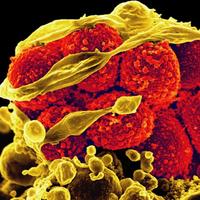
Feb 24, 2017
It's been almost two years since we learned about CRISPR, a ninja-assassin-meets-DNA-editing-tool that has been billed as one of the most powerful, and potentially controversial, technologies ever discovered by scientists. In this episode, we catch up on what's been happening (it's a lot), and learn about CRISPR's potential to not only change human evolution, but every organism on the entire planet.
Out drinking with a few biologists, Jad finds out about something called CRISPR. No, it’s not a robot or the latest dating app, it’s a method for genetic manipulation that is rewriting the way we change DNA. Scientists say they’ll someday be able to use CRISPR to fight cancer and maybe even bring animals back from the dead. Or, pretty much do whatever you want. Jad and Robert delve into how CRISPR does what it does, and consider whether we should be worried about a future full of flying pigs, or the simple fact that scientists have now used CRISPR to tweak the genes of human embryos.
This episode was reported and produced by Molly Webster and Soren Wheeler. Special thanks to Jacob S. Sherkow.
Support Radiolab by becoming a member today at Radiolab.org/donate.